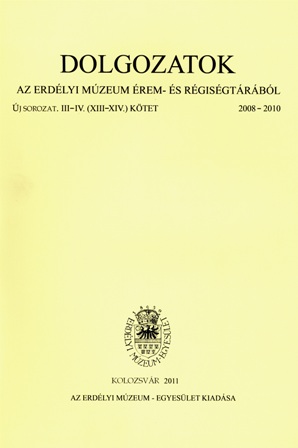Magyarvista középkori templomának újonnan feltárt freskó
The Newly Uncovered Medieval Frescoes from Magyarvista/Viștea
Author(s): Tekla SzabóSubject(s): History, Cultural history, Visual Arts, Recent History (1900 till today), 13th to 14th Centuries
Published by: Erdélyi Múzeum-Egyesület
Keywords: medieval frescoes; church; bishop of Transylvania; Magyarvista; István Gróh; Virgin Mary; Crucifixion
Summary/Abstract: Magyarvista, a small village near Kolozsvár (Cluj), was the property of the bishop of Transylvania. The church, now a Calvinist one, was built in the second half of the 13th century. The frescoes covering the walls of the nave were discovered during the renovations in 1912. 11 aquarelle copies were made by István Gróh in 1913. In 1920 the paintings were covered with plaster. The new renovation (summer of 2008) was made just on two scenes. The first fresco represents the Crucifixion: at the arch in a rounded decorative frame we can see Christ on the cross, sided by the Virgin Mary and Apostle John holding the book. Neither face is maintained. The composition continues in a simple red frame lower on the southern wall. We can see two more persons both with lance and shield. The first is Longinus. The second person is dressed sumptuously and modern: he has a belt with imitation of different precious stones and pearls. Is it the representation of the donor of an altar that could be identified in that place? The essential characteristics of this fresco are those of the “Italo-Byzantine“ style also found in a number of Transylvanian locations: Csíkszentimre (Sântimbru), Felvinc (Unirea), İraljaboldogfalva (Sântămăria Orlea). Magyarvista seems to be painted after 1320, when a loyal of the king Charles I of Hungary, the 27 year old Andreas Széchy was elected as bishop of Transylvania. The later fresco in the southern side of the nave is dated from the last half of the 14th century. It is an example for the influence of the Italian Trecento. Together with Bádok (Bădesti) and Magyarfenes (Vlaha) the frescoes indicate that the area of Kolozsvár was one of the Transylvanian centers of this style. The composition in Cosmatesque band incorporates standing saints (St. James the Greater, St Nicolas, a holy king of Hungary) and the Madonna Hodegetria. She is blessing supposedly the donor, dressed in clerical robe with pallium. In the middle we can see a ship with figures dressed fashionably, in the front a person with tonsure (possibly the same donor) is praying to the iconic figure of Mary. In the middle a woman is covering her eyes with her maphorion. There is a star on her front; the characteristic of Our Lady of the Seas. There are secondary elements that also occur in the Navicella of Giotto (flying wind demons, the figure covering his eye, the donor). Other features are similar with that kind of composition in which the ship-church metaphor is illustrated by the image of the Saviour crucified on the mast, in the ship with all the believers. As a conclusion we can say that the image combines iconographic elements from more sources and creates a new original composition presumably meant to ask the protection for the donor’s longer trip to Heaven. He seems to be Imre Czudar, bishop of Transylvania from 1386 to 1389. Before this, in 1374 he took part in a delegation to Charles V of France. On the way back home he passed through Avignon and Rome. This event seems to be illustrated by his repeated hypothetical depiction in the ship.
Journal: Dolgozatok az Erdélyi Múzeum Érem- és Régiségtárából. Új sorozat
- Issue Year: 2010
- Issue No: III-V
- Page Range: 139-160
- Page Count: 22
- Language: Hungarian

